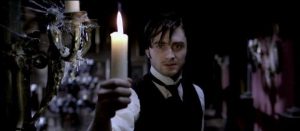 While it’s a cheap thrill to see Hammer Film Productions — purveyor of so many other cheap thrills during the 1930s-’80s — back in business after decades in purgatory, their first post-revival production is a reminder of what drained the life from the iconic schlock factory and sent it into limbo to begin with: cheap, slap-dash, toothless horror flicks that attempt to coast on style and atmosphere without delivering anything of substance. To be perfectly and unashamedly nerdy about, The Woman in Black is Charles Dickens by way of M.R. James, only not as much fun.
While it’s a cheap thrill to see Hammer Film Productions — purveyor of so many other cheap thrills during the 1930s-’80s — back in business after decades in purgatory, their first post-revival production is a reminder of what drained the life from the iconic schlock factory and sent it into limbo to begin with: cheap, slap-dash, toothless horror flicks that attempt to coast on style and atmosphere without delivering anything of substance. To be perfectly and unashamedly nerdy about, The Woman in Black is Charles Dickens by way of M.R. James, only not as much fun.
The film (adapted from the book by Susan Hill) resurrects the cliched gothic haunted house movie and stunt-casts a post-Potter Daniel Radcliffe as Arthur Kipps, a young attorney and single father whose wife died in childbirth. As the story opens, he’s dispatched to a coastal village to tidy the affairs of the recently deceased Alice Drablow and pave the way for the sale of her estate, the charmingly named Eel Marsh House.
It doesn’t take him long to get the feeling that something just isn’t right. The eccentric locals make Kipps feel about as welcome as an Ebola outbreak, their children are never seen outdoors, and there’s so many sidewise glances exchanged that it’s obvious either something unsavory is going on, or half the villagers have a flatulence problem and the other half is just too polite to say anything about it.
The house is even less appealing — a stock haunted manor, it’s dank, overgrown with ivy, shrouded in more fog than a Def Leppard video, remotely located in the middle of the marshes, and only accessed via a treacherous road that is submerged when the tide comes in. Kipps makes the dubious decision to spend the night there in order to complete his work. Of course, things start bumping and screeching in the night (and not in a good way), and Kipps is assailed by visions of dead children and the titular spectre. Kipps’ investigations raise a buried mystery that the movie never bothers to fully explain before it concludes with an unsatisfying twist.
Director James Watkins succeeds in establishing an atmosphere of dread at the outset and manages to generate a couple of good scares, but the goings on are quickly deflated by stilted characters, anemic pacing, and repetitive scenes of Radcliffe wandering the same creepy woods, bounding up and down the same staircase, and wandering in and out of the same rooms. It’s great the Hammer tradition of frugality has been applied towards milking the location for all its worth, but couldn’t they have at least found a bigger house?
As for Radcliffe, he’s challenged with a expressing a range of emotion running from depressed to anxious to really anxious, with occasionally flashes of boredom and drowsiness. The talented young actor has so far proven himself to be more than a one-trick pony with talented turns in acclaimed stage productions of Equus and How to Succeed in Business Without Really Trying, in the art house drama December Boys, and via a legendary self-parody guest appearance on Extras. Why is his skill being wasted with lifeless dreck like this?





